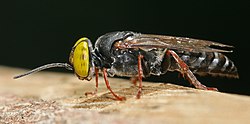| Crabronidae | |
|---|---|
 | |
| Tachysphex sp. | |
| Scientific classification | |
| Domain: | Eukaryota |
| Kingdom: | Animalia |
| Phylum: | Arthropoda |
| Class: | Insecta |
| Order: | Hymenoptera |
| Superfamily: | Apoidea |
| Family: | Crabronidae Latreille, 1802 |
| Subfamilies | |
Crabronidae is a large family of wasps within the superfamily Apoidea. [1] [2]
